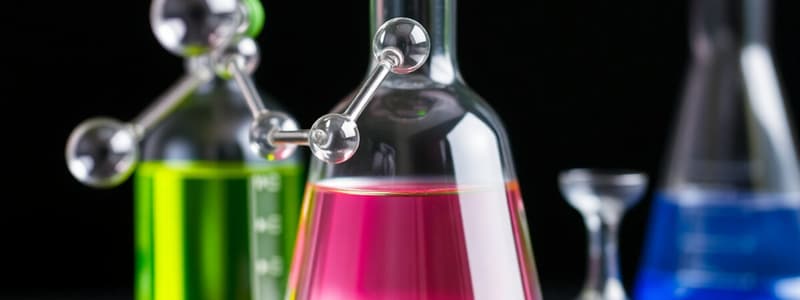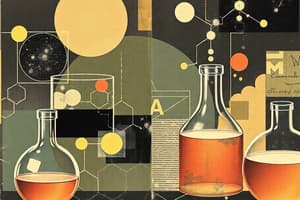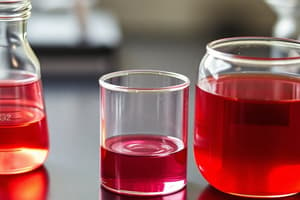Podcast
Questions and Answers
Which of the following statements about compounds is true?
Which of the following statements about compounds is true?
- Compounds are formed when elements are physically combined.
- Compounds have properties that change when formed.
- Compounds are formed when two or more elements are chemically bonded. (correct)
- Compounds can only consist of metals.
Isotopes of an element have different chemical properties.
Isotopes of an element have different chemical properties.
False (B)
What is the primary difference between metals and nonmetals in terms of electron behavior during chemical bonding?
What is the primary difference between metals and nonmetals in terms of electron behavior during chemical bonding?
Metals lose electrons to become cations, while nonmetals gain electrons to become anions.
The elements that have properties of both metals and nonmetals are called __________.
The elements that have properties of both metals and nonmetals are called __________.
Match each type of molecular compound with its description:
Match each type of molecular compound with its description:
Flashcards
Compounds
Compounds
Two or more elements chemically combined in a fixed ratio.
Mixtures
Mixtures
Two or more substances physically mixed together, where the properties of each substance remain unchanged.
Isotopes
Isotopes
Atoms of the same element that have the same number of protons but a different number of neutrons.
Metalloids
Metalloids
Signup and view all the flashcards
Groups on the Periodic Table
Groups on the Periodic Table
Signup and view all the flashcards
Study Notes
Compounds and Mixtures
- Compounds are formed when two or more elements are chemically bonded
- Mixtures are formed when two or more elements are physically bonded (properties are not changed, e.g., ice melting)
Isotopes
- Isotopes are of the same element with a different number of neutrons
- Mass = protons + neutrons
Atomic Mass Unit (AMU)
- Atomic mass unit (AMU) is calculated by combining the mass abundance
Metalloids
- Metalloids: B, As, Sb, Si, Te, Ge
Periodic Table Groups
- Elements in the same group on the periodic table have similar chemical properties and similar valence electrons (vertical)
- Metals are to the left of the step-like line on the periodic table
- Non-metals are to the right of the step-like line on the periodic table
Chemical Bonding
- In chemical bonding, metals lose electrons to become positively charged ions (cations)
- In chemical bonding, non-metals gain electrons to become negatively charged ions (anions)
- Only when it is a bond between a metal and a non-metal
- When a cation forms, the radius of the metal becomes smaller
- Anions are larger than their parent element
Molecular Compounds
- Molecular compounds share electrons
- Polar molecular compounds (asymmetrical) share electrons unequally
- Non-polar molecular compounds (symmetrical) share electrons equally
Studying That Suits You
Use AI to generate personalized quizzes and flashcards to suit your learning preferences.
Description
This quiz explores the fundamental concepts of compounds, mixtures, isotopes, and chemical bonding. You will also learn about the periodic table groups and the properties of metalloids. Test your understanding of these key chemistry topics.





